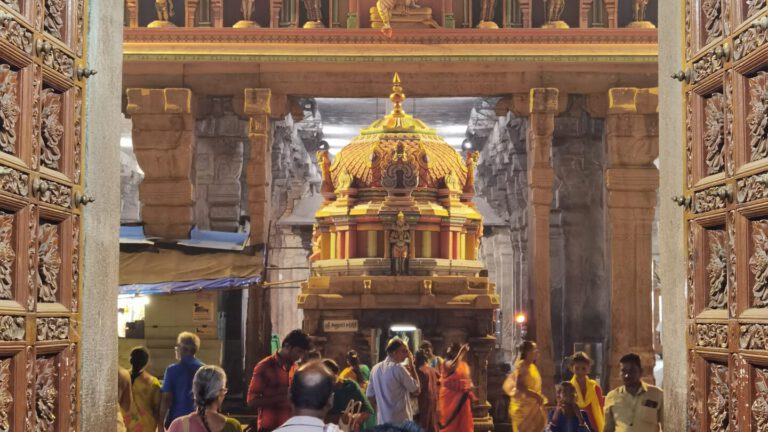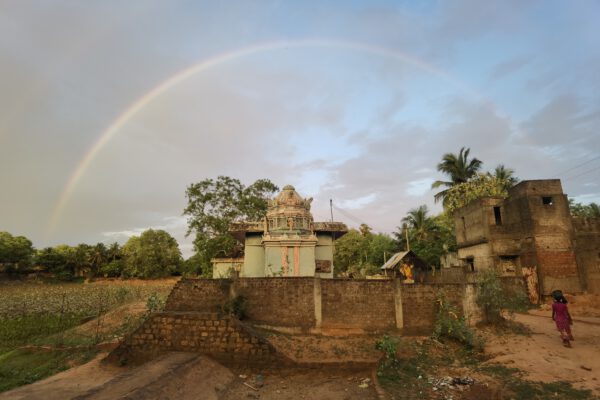What is sacred space and what is not? Meanwhile, I find it much easier to say what is a sacred space than to say what is not.
I had always been drawn to churches in Europe. Not to their iconography, because the imagery of the Bible, a dead man on a cross, I always found that irritating. The ’sacred spaces‘ in the Christian space are primarily Catholic churches, because Protestant churches, by definition, are not sacred spaces, they are more like gathering spaces where a community meets.
Catholic churches, then, or those built by Catholics, have a special aura of contemplation and silence. The sparse light, the vaults, the side aisles, the perspectives that open up in these spaces, the seclusion from the civil society outside, that is, the inside and outside, the interior and exterior… all these elements have always attracted me. Again and again I went into churches, sat down for a few minutes, came to rest. But there was always that cross, the guilt and forgiveness, death and despair that never let me stay there for long. Churches have always been a refuge for me, no more, but also no less. My favorite thing in churches was when the organ was played, then there was only the space and the vibration, the light, the perspective, the inside, so no material space and also no ideology or religion.
Temples in the Mediterranean
My experience with temples in Italy, France, Greece, Egypt was quite different. In Greece and Egypt I saw only ruins, national monuments, tourist attractions. But still, the way they stood in the landscape was impressive. Open to the elements, largely freed from iconographic ideology by devastation and neglect, these sites are refuges of a connection with nature, history, the cosmos; they bear witness to a bygone era and set the imagination free.
I think of Winkelmann and the Renaissance, the dramas of ancient Greece, the tombs of the pharaohs and hieroglyphs. In these ruins blows a spirit, as they say in German. This spirit of the pantheon of the gods of Olympus, which overlaps with those of the Egyptians and Romans, describes another world. A world characterized by polytheism, mythological stories, contradictions and all too human conflicts. It is a mirror of social man, at least that’s how I’ve always understood it, and I’m probably not alone in that. It made sense to me that the human spirit would mirror itself in grand narratives to explore itself and share the experience. These stories then became stories of power and politics.
Temples in India
How different are the temples in India. They are alive with tradition anchored in the now. The gods have been worshipped since the time of the Vedas or even longer. The pantheon of gods is not a mirror of the people, it is the origin. The gods represent the forces of the universe: physical forces, psychological and emotional forces, life forces, and forces that we cannot yet name, because it would be silly to think we already know everything. So when I go to an Indian temple, it is a combination of the experience of Europe, enhanced by the experience of a living tradition that integrated different kinds of yoga. The sutras are one thing, vibration is another. Vibration is the center of Indian spirituality. In the sound OM this is expressed. Matter and energy, consciousness, life are just different forms of vibration. Therefore, in Indian philosophy as interpreted by Sri Aurobindo, there are 7 levels of existence: matter, life, rational mind, ideal knowledge, bliss, consciousness and pure existence. It is not meaningful to try to understand the culture of India without perceiving this distinction.
When I enter a temple, I feel that all these levels are activated.
This activation of the holistic self is reflected in the ancient temples in the form of the Vastupurusamandala. Vastu is the art of architecture, Purusa is the primal soul, Mandala is the sacred geometric form. These three elements form the matrix of most of the ancient great temples of India.So when I enter a temple, I enter a spiritual space. Temples are not a reflection of society and man’s self-image; for many, they are society in themselves and the core of human existence. They are based on a holistic knowledge that not only recognizes our 7 forms of existence, but also synthesizes the different forms of knowledge. Because already at the time of the Veda there was the knowledge of art and music, Ayurveda, Sutras, different forms of Yoga: Karma (action), Hatha (power), Tantra (energy), Bhakti (prayer), Jnana (knowledge), Raja (meditation).
Temples are for quite personal universities of life.











